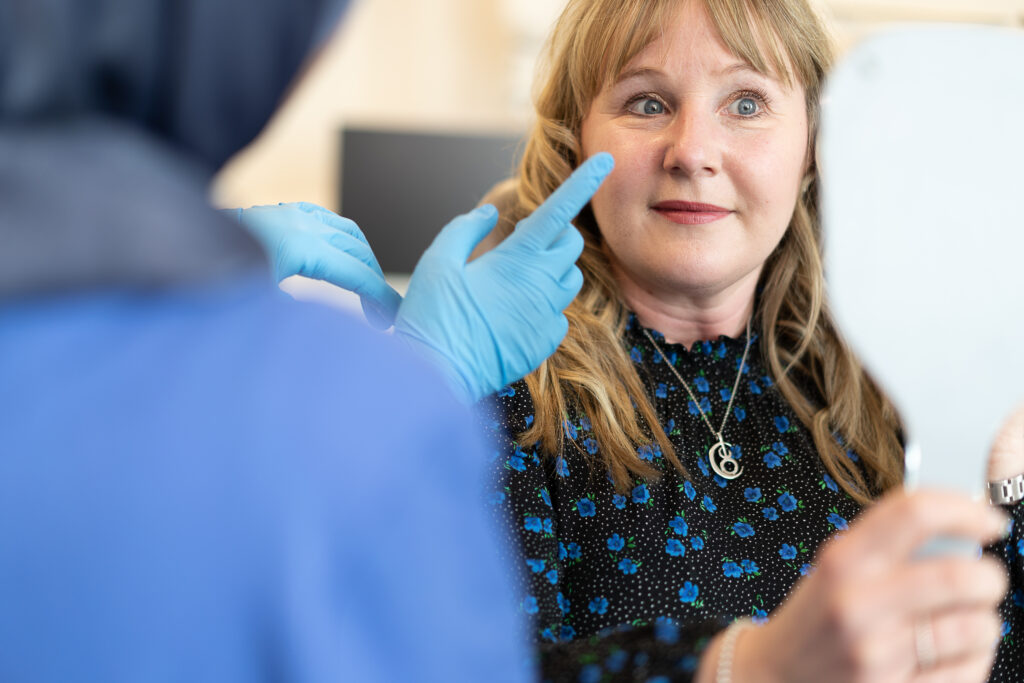What are skin lesions?
Skin lesions can be defined as any abnormal change in the skin, encompassing a wide range of conditions. There are various types, ranging from benign to malignant. Non-cancerous (benign) lesions include conditions such as moles (nevi), skin tags (acrochordons), seborrheic keratosis (wart-like growths), and cysts (fluid-filled sacs). Warts, caused by a viral infection, also fall into this category. Precancerous lesions include actinic keratosis, which can develop into skin cancer if left untreated. Malignant lesions include basal cell carcinoma, squamous cell carcinoma, and melanoma, all types of skin cancer that can spread if not treated early. Other lesions may result from conditions like eczema, psoriasis, rosacea, and infections (e.g., impetigo), which can cause redness, scabbing, and ulceration. Each type of skin lesion has distinct characteristics, and treatment varies based on the nature and risk of the lesion. Recognising the significance of these lesions in a specific area of skin guides appropriate treatment decisions.
Reasons for removing skin lesions
A major reason for removing skin lesions is the potential risk of malignancy, as they can develop into skin cancer, necessitating early detection and removal. For example, most malignant skin lesions, including basal cell carcinoma, which accounts for around 80% of skin cancer cases, typically appears as raised, pearly bumps on sun-exposed skin and the surrounding skin. Melanomas, although less frequent, are more aggressive and can vary in colour and shape.
Chronic irritation caused by skin lesions is another common reason for removal. Lesions that rub against clothing or cause discomfort can significantly affect one’s quality of life. Symptoms like itching or pain from irritation often prompt individuals to seek relief through removal.
Aesthetic considerations also play a significant role. Many people choose to remove skin lesions for personal preference, aiming for a clear and smooth skin appearance. Weighing the benefits against the risks is crucial, as removing benign lesions might lead to unnecessary complications.
Types of skin lesions
Skin lesions come in many forms, each requiring different approaches for diagnosis and treatment. Malignant skin lesions, such as skin cancers, are among the most serious and require immediate attention. Skin cancer is the most common type of cancer in the UK, with approximately 1 in 4 men and 1 in 5 women developing some form of skin cancer during their lifetime. Cancerous lesions, including basal cell cancer, squamous cell carcinoma, and melanoma, can be life-threatening without proper treatment.
Benign skin lesions, while generally harmless, can still cause concern due to their appearance or discomfort. Seborrheic keratoses, for instance, are benign tumours that appear as raised, waxy bumps and are often mistaken for skin cancer. Keratoacanthomas are another type of benign lesion that typically occurs on sun-exposed skin and can be confused with squamous cell carcinoma. Cysts can also be a type of benign skin lesion.
Accurate diagnosis and monitoring are vital since benign lesions like seborrheic keratoses and keratoacanthomas can be similar to malignant ones, despite not being life-threatening and being classified as noncancerous.
Hospital fee guide price: £1,794*
More about pricingBefore treatment
Effective skin lesion removal starts with a thorough diagnosis and consultation. Doctors and a dermatologist review your medical history to identify factors affecting treatment, ensuring accurate diagnosis and discussing removal options in dermatology, including skin excision. A consultant can also provide valuable insights during this process.
Signing a consent form before any procedure ensures that patients have received comprehensive information about the risks involved, fully understand the implications, and are prepared for the process ahead.
Preparing for skin lesion removal
Successful skin lesion removal requires thorough preparation. Patients should disclose all medications and allergies to their healthcare provider. Those on anticoagulants like warfarin must arrange a blood test to ensure safe levels before surgery. Avoiding non-steroidal anti-inflammatory drugs, aspirin, and certain herbal remedies at least a week before the operation is also recommended.
Patients should wear loose-fitting clothing and bring a list of their current medicines on the day of surgery. It’s wise to arrange for someone to accompany them home, particularly if the procedure involves the central face area, as advised. Loose-fitting clothing should be worn for comfort, so they can leave feeling at ease.
During treatment
At the beginning of the procedure, the area around the lesion is numbed with a local anaesthetic injection, keeping the patient comfortable throughout.
Surgical removal methods
Several surgical methods are suited to different types of lesions.
- Cryotherapy uses liquid nitrogen to freeze and eliminate benign lesions like warts and actinic keratoses.
- Electrocautery employs a heated probe to burn off skin lesions, effectively removing a small amount of clean benign lesions but isn’t suitable for larger or malignant ones.
- Excision biopsy involves completely cutting out the lesion with a scalpel and stitching the wound closed. This method is often used when there is a need to examine the removed tissue under a microscope.
Each method has its benefits and limitations based on the type and location of the lesion on the body. If a sample has been taken, the excised tissue specimen is then sent to a pathologist department for evaluation to determine if any further treatment is needed. This step confirms the diagnosis and ensures all abnormal cells are examined and removed.
After treatment
Post-procedure care ensures a smooth recovery. Taking pain relief like paracetamol can manage discomfort once the anaesthetic wears off. Proper wound care, including cleanliness and monitoring for infection, is crucial. Antibacterial ointments can prevent infections that might cause scarring during healing.
Avoid picking scabs to prevent disrupting healing and increasing scarring. Stitches, if used, must remain in place for a specific duration. Seek medical advice if the wound opens or stitches are removed prematurely.
Refrain from strenuous activities, including heavy lifting and exercise, for at least the first few days of rest post-procedure to avoid soreness.
Minimising scarring and improving cosmetic appearance
Minimising scarring is a common concern after skin lesion removal. Scarring is normal and most noticeable initially but generally fades over time. Applying a thin layer of soft paraffin ointment post-stitch removal can moisturize and promote scar healing. Keeping the wound moist accelerates healing and minimises scarring.
Protecting the treated area from sun exposure is essential, as UV rays can cause discoloration and exacerbate scarring. Proper care and patience can significantly improve the cosmetic appearance of the treated area.
Long-term recovery and follow-up
Recovery varies per individual and the type of procedure performed.
For persistent scars, professional treatments like laser therapy or chemical peels can significantly improve their appearance. Consistently practicing proper skin care and attending all follow-up appointments can lead to the best long-term outcomes.
Potential complications and risks
Like any surgical procedure, skin lesion removal comes with potential complications and risks. Be vigilant for symptoms like excessive bleeding, redness, or swelling, and report these to your doctor promptly. Infection is a primary concern, making it essential to follow all aftercare instructions carefully, including monitoring for bruising.
Appointment and Treatment Plan
Appointment
Based on your previous consultation with a doctor, an appointment will be arranged between you and your surgeon.
Treatment plan
During this appointment, you’ll go through your medical history, the surgery, the recovery, and together, you’ll decide whether this is a viable option for you.
Pre-op assessment
If surgery is an option, then the surgeon and their team will thoroughly assess whether you’re right for the surgery. They’ll consider your current health, any previous issues, and other external matters.
Surgery
Prior to going through the surgery, our team will ensure that you’re prepped once again. If everything is confirmed, you’ll undergo the surgery and then we’ll explain the aftercare instructions.
Aftercare
If necessary, you’ll stay in a ward for a few hours to ensure that you’re ready to go home after the surgery. However, this may depend on the surgery outcome and whether you need moderate or light assistance.
Follow-Up
You’ll come in a few weeks later and we’ll give you one final check-over to ensure that you’re on track for recovery.
Experts
We are proud to provide patients with access to a wide range of clinicians, chosen specifically for their knowledge and reputation in their area of expertise. Our experts align with our values: putting you at the centre of your care and educating you on your options at each step of the journey. We encourage you to learn more about our clinicians and how they can help you below. As always, please contact our patient services team if you require any additional information.
We offer 3 ways to pay for your treatment
We exist to take the stress out of private healthcare.
Our payment options are designed to offer you easy access to our treatments and services. You can choose to pay on the day, spread the cost, or use your private medical insurance.
Our patient services team will guide you through the process, providing clear costs and support throughout your course of treatment so you can focus on the thing that matters most – your health.
Whether you pay in advance, spread the cost, or use your private medical insurance, rest assured you will be receiving exceptional care 365 days a year.
Pay in Advance
Even if you do not have medical insurance, you can still get quick and comprehensive access to private medical care.
We provide transparent pricing from your initial consultation to the completion of your treatment so you know where your stand, every step of the way.
We accept all major debit and credit cards, as well as Apple Pay for UK residents. Please note that we do not accept cash or cheques.
Pay monthly
Paying for your treatment at OSD Healthcare doesn’t need to mean settling the full cost in one go.
Many of our treatments have a pay monthly option that allows you to spread the cost of your treatment over 12 months with no credit checks required.
A minimum spend of £300 does apply. We’ll take your first payment upfront and then arrange a direct debit for your monthly payments thereafter. It’s that simple.
Pay using PMI
We are recognised by all major health insurance companies and with our extensive range of services, there are lots of benefits to using your insurance with us. Our patient services team is here to answer any questions you may have about using your private health insurance with us.
Please bring along your policy details including your scheme details, membership or policy number, expiry date and confirmation of eligibility to claim (i.e. your authorisation number). If you do not have these details with you, we will require payment from you on the day. Patients are liable for any amounts not settled by their insurer.
Pricing
Hospital fee guide price: £1,794
Procedure price subject to bespoke quotation.
Additional consultant fee not included.
FAQs
It is advisable to remove skin lesions primarily to eliminate concerns regarding potential malignancy, alleviate chronic irritation, or improve aesthetic appearance. Taking action can ensure both your health and comfort.
Common types of skin lesions include benign lesions such as acne and moles, as well as malignant forms like basal cell carcinoma and melanoma. Understanding these distinctions is crucial for effective skin health management.
You can expect the procedure to involve numbing the area with a local anaesthetic, followed by the excision of the lesion, with tissue being sent for evaluation afterward. It is important to follow post-procedure care instructions for optimal recovery.
To minimise scarring after removal, keep the wound moisturised, protect it from sun exposure, and consider using silicone sheets or gels. These practices significantly contribute to better healing outcomes.
Complications of skin lesion removal may include infection, excessive bleeding, and scarring. Adhering to aftercare instructions is crucial to minimise these risks.









